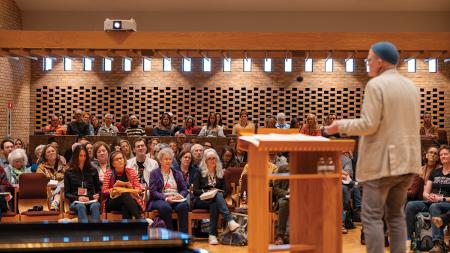Telling the Story of Preaching

When he looks out over a church before starting to preach, Rev. Scott Hoezee sees people who have brought a wide range of personal stories—some happy, some sad, some about triumph, and others about sorrow.
Given the stress and strain some people feel and the joy that others experience, Hoezee says it can be hard to determine how to best bring a gospel message that touches everyone.
But he’s come to believe that the best way to share the gospel with these people who have so many tales to tell is to be a storyteller himself, says Hoezee in his new book Actuality: Real Life Stories for Sermons that Matter.
“Real stories work,” he writes. “Real human beings process reality in narrative terms, such that stories in sermons that reflect the lives that we all lead in this world will resonate with people at a very deep, basic level.”
That doesn’t mean he ignores the gospel text, or the stories in it. But rather, he uses other stories whenever appropriate to enhance the gospel’s meaning, says Hoezee, former pastor of Calvin CRC in Grand Rapids and director of the Center for Excellence in Preaching at Calvin Theological Seminary.
Hoezee’s book is is part of Artistry in Preaching Series. Next week, Rev. Peter Jonker, pastor of Lagrave CRC in Grand Rapids, will be talking to Hoezee about his book at an invitation-only event at the seminary.
"Scott Hoezee’s book pulls back the veil of the preacher’s study and helps us to see some of the craft involved in a memorable sermon,” says Jonker.
“Scott focuses on a massive part of the preaching enterprise: namely the choosing and telling of stories. Drawing from literature and film and everyday life, Scott helps preachers see the difference between stories that sink deep and stories that bounce off the surface.”
Hoezee says his book contains advice he gives his preaching students, telling them that the Bible is a book of stories, rich with meaning and full of applications.
He also tells his students to always be on the lookout for stories — in real life, in the news, in literature, in films, and elsewhere — that can help illustrate a gospel text.
Hoezee writes how he has found preaching material in the prize-winning novel To Kill a Mockingbird by Harper Lee, the movie Groundhog Day in which Bill Murray keeps awakening to the same day, and a New York Times article offering the shattering snapshot of a thirteen-year-old girl battling bad self esteem amidst poverty.
Indeed, the book makes it especially clear that the stuff of everyday life — the hurt, pain, disappointment and longings, as well as the joy and grace — can be addressed in church on Sunday in ways that deeply touch the heart.
“The goal is to preach sermons that will have real-life traction for those who listen,” he writes, adding that the goal of a good sermon is to focus on God’s great grand grace.
Although the book is principally for preachers, says Hoezee, “I do hope it would be of interest to people who listen to sermons and are invested in what makes sermons good and/or what could help make them better.”
He also makes it clear that, however good the stories, the primary purpose of preaching remains to speak the word of God.
“Of course it is only the word and the Spirit that wing any sermon into people’s hearts,” he writes. “The preacher is at best the midwife in the procedure.”


